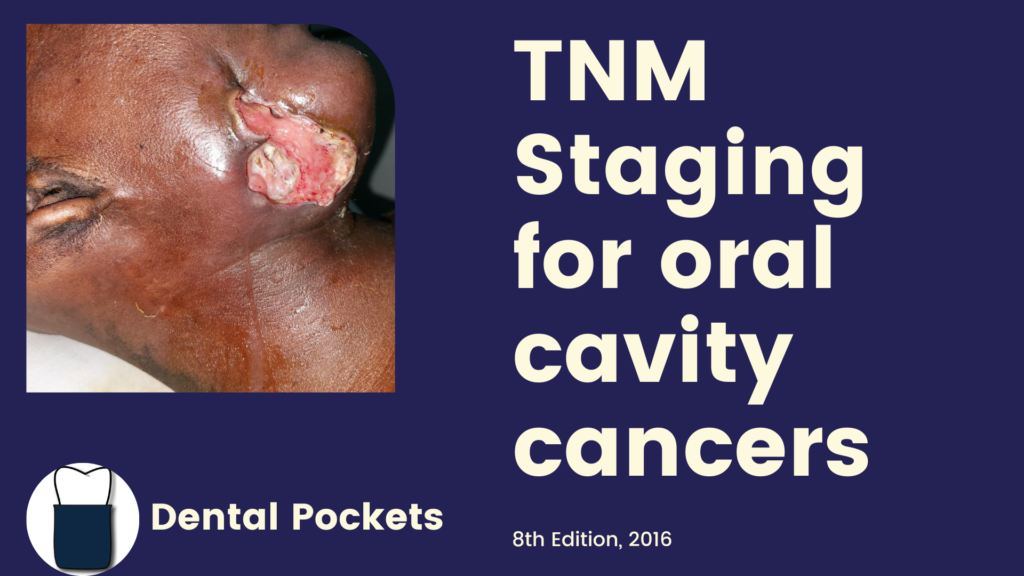TNM Staging for oral cavity cancers is very well known and very well used. Lets look into it specifically the 8th edition with the addition of DOI which you’ll read later on.
Abbreviations
American Joint Committee on Cancer (AJCC)
International Union Against Cancer (UICC)
History
TNM Staging for oral cavity cancers: In 1944, Pierre Denoix proposed a staging system for solid tumors based on tumor characteristics (T), nodal spread (N) and distant metastasis (M)[1]. The UICC adopted this system in 1954. The AJCC was established in 1958. The first edition of the AJCC/UICC TNM classification was published in 1987. Since then, the TNM classification has been widely used not only to plan treatment and to reliably estimate the prognosis of patients but also to evaluate treatment results and to compare outcomes between institutions in different parts of the world [1, 2].
Introduction
The American Joint Committee on Cancer (AJCC)/International Union Against Cancer (UICC) staging system is a tool which provides clinicians across the world with the ability to stage cancer prior to any treatment (cTNM), after surgical resection (pTNM), and at recurrence (rTNM). Staging stratifies patients into various prognostic groups and, based on the stage of the disease, it is possible to select best treatment option, plan the treatment, and estimate prognosis.
Twenty-eight specialists from various disciplines with expertise and knowledge in head and neck cancer biology and staging formed the AJCC Head and Neck Task Force. The group analyzed in detail chapters from the 7th edition and proposed changes to incorporate new information. When the task force recommended changes, additional analyses were performed to confirm if there is available data to support the modifications [4]. The modifications that were published in the 8th edition of the AJCC/UICC TNM staging system are mentioned below.
The greatest dimension of the tumor was the most important characteristic for the T stage categories in oral cancer. Since depth of invasion (DOI) has been shown to have prognostic implications, with deeper tumors showing an increased risk of nodal metastases and decreased disease-specific survival, this parameter was included in the categorization of T stages in the AJCC 8th edition.
Clinical assessment of accurate DOI can be challenging but differentiation among thin (≤ 5 mm), intermediate (> 5 mm and ≤ 10 mm) and thick (> 10 mm) lesions is usually possible in the hands of experienced head and neck surgeons.
Table 1.
Primary tumor (T) definition for oral cavity cancers.
| TX | Primary tumor cannot be assessed |
| Tis | Carcinoma in situ |
| T1 | Tumor ≤ 2 cm and DOI ≤ 5 mm |
| T2 | Tumor ≤ 2 cm, DOI > 5 mm and ≤ 10 mm or tumor > 2 cm and ≤ 4 cm and DOI ≤ 10 mm |
| T3 | Tumor > 4 cm or any tumor with DOI > 10 mm |
| T4 T4a T4b | Tumor invades adjacent structures only (e.g., through cortical bone of mandible or maxilla, or involves the maxillary sinus or skin of the face) Tumor invades masticator space, pterygoid plates, or skull base and/or encases the internal carotid artery |
*DOI: depth of invasion. AJCC is currently discussing further refinement of T-stage stratification for small tumors (< 2 cm) with DOI > 10 mm.
From: Amin MB, E.S., Greene FL, et al, eds, AJCC Cancer Staging Manual. 8th ed. Springer International Publishing: American Joint Commission on Cancer; 2017, New York.
Table 2.
Clinical assessment of regional lymph nodes (cN).
| NX | Regional lymph nodes cannot be assessed |
| N0 | No regional lymph node metastasis |
| N1 | Metastasis in a single ipsilateral lymph node, ≤ 3 cm and ENE- |
| N2 N2a N2b N2c | Metastasis in a single ipsilateral lymph node > 3 cm and ≤ 6 cm and ENE-; or metastases in multiple ipsilateral lymph nodes, ≤ 6 cm and ENE-; or in bilateral or contralateral lymph nodes, ≤ 6 cm and ENE- Metastasis in a single ipsilateral lymph node > 3 cm and ≤ 6 cm and ENE- Metastases in multiple ipsilateral lymph nodes, ≤ 6 cm and ENE- Metastases in bilateral or contralateral lymph nodes, ≤ 6 cm and ENE- |
| N3 N3a N3b | Metastasis in a lymph node > 6 cm and ENE-; or metastasis in any lymph node(s) with ENE+ clinically Metastasis in a lymph node > 6 cm and ENE- Metastasis in any lymph node(s) with ENE+ clinically |
From: Amin MB, E.S., Greene FL, et al, eds, AJCC Cancer Staging Manual. 8th ed. Springer International Publishing: American Joint Commission on Cancer; 2017, New York.
Table 3.
Pathological assessment of regional lymph nodes (pN).
| NX | Regional lymph nodes cannot be assessed |
| N0 | No regional lymph node metastasis |
| N1 | Metastasis in a single ipsilateral lymph node, ≤ 3 cm and ENE- |
| N2 N2a N2b N2c | Metastasis in a single ipsilateral lymph node, ≤ 3 cm and ENE+; or metastasis in a single ipsilateral lymph node > 3 cm and ≤ 6 cm and ENE-; or metastases in multiple ipsilateral lymph nodes, ≤ 6 cm and ENE-; or in bilateral or contralateral lymph nodes, ≤ 6 cm and ENE- Metastasis in a single ipsilateral lymph node, ≤ 3 cm and ENE+; or metastasis in a single ipsilateral lymph node > 3 cm and ≤ 6 cm and ENE- Metastases in multiple ipsilateral lymph nodes, ≤ 6 cm and ENE- Metastases in bilateral or contralateral lymph nodes, ≤ 6 cm and ENE- |
| N3 N3a N3b | Metastasis in a lymph node > 6 cm and ENE-; or metastasis in a single ipsilateral node larger than 3 cm in greatest dimension and ENE+; or multiple ipsilateral, contralateral, or bilateral nodes, any with ENE+; or a single contralateral node of any size and ENE+ Metastasis in a lymph node > 6 cm and ENE- Metastasis in a single ipsilateral node larger than 3 cm in greatest dimension and ENE+; or multiple ipsilateral, contralateral, or bilateral nodes, any with ENE+; or a single contralateral node of any size and ENE+ |
From: Amin MB, E.S., Greene FL, et al, eds, AJCC Cancer Staging Manual. 8th ed. Springer International Publishing: American Joint Commission on Cancer; 2017, New York.
To read more such articles from Oral & Maxillofacial Surgery, click here.
I hope this article provides you with the much needed information on TNM Staging for oral cavity cancers (8th edition).
Reference:
- Amin MB, Greene FL, Edge SB, et al. The Eighth Edition AJCC Cancer Staging Manual: Continuing to build a bridge from a population-based to a more “personalized” approach to cancer staging. CA Cancer J Clin. 2017;67(2):93-99. doi:10.3322/caac.21388
- Zanoni DK, Patel SG, Shah JP. Changes in the 8th Edition of the American Joint Committee on Cancer (AJCC) Staging of Head and Neck Cancer: Rationale and Implications. Curr Oncol Rep. 2019 Apr 17;21(6):52. doi: 10.1007/s11912-019-0799-x. PMID: 30997577; PMCID: PMC6528815.


